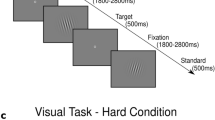Abstract
The checkerboard-onset evoked potential does not obtain its adult waveform until late puberty. The changing waveform results from the development of the underlying sources originating in distinct areas of the visual cortex. Since the waveform of checkerboard-onset evoked potential also varies with check size, we studied the dependency of the activity of these sources on check size.
A dipole source localization procedure yielded the position and orientation of the equivalent dipoles and the constituent components of the pattern-onset evoked potential, each corresponding to one of these dipoles. For every check size used, the checkerboard-onset evoked potential could be described by a summation of the relative amplitudes of these components. Since the relative amplitude versus check size curves showed a different behavior for each source, they provided evidence of functionally distinct cortical generators. The strength of the striate source was especially sensitive to the fine structure of a pattern, whereas the extrastriate sources contributed mainly for coarse pattern elements.
Similar content being viewed by others
References
Jeffreys DA, Axford JG. Source locations of pattern specific components of human visual evoked potentials. I. Component of striate cortical origin. Exp Brain Res 1962; 16: 1–21.
Jeffreys DA, Axford JG. Source locations of pattern specific components of human visual evoked potentials. II. Component of extrastriate cortical origin. Exp Brain Res 1972; 16: 22–40.
Spekreijse H, Van der Tweel CH, Zuidema T. Contrast evoked responses in man. Vision Res 1973; 13: 1577–1601.
Jeffreys DA. The physiological significance of pattern visual evoked potentials. In: Desmedt JE, ed. Visual evoked potentials in man: new developments. Oxford: Clarendon Press, 1977: 134–67.
Lesèvre N, Joseph JP. Modifications of the pattern evoked potential (PEP) in relation to the stimulated part of the visual field. Electroencephalogr Clin Neurophysiol 1979; 47: 183–203.
Maier J, Dagnelie G, Spekreijse H, Van Dijk BW. Principal components analysis for source localization of VEPs in man. Vision Res 1987; 27: 165–177.
Ossenblok P, Spekreijse H. The extrastriate generators of the EP to ceckerboard onset. A source localization approach. Electroencephalogr Clin Neurophysiol 1991; 80: 181–93.
Ossenblok P, Reits D, Spekreijse H. Analysis of the striate activity underlying the checkerboard onset EP of children. Vision Res 1992; 32: 1829–35.
Ossenblok P, De Munck JC, Wieringa HJ, Reits D, Spekreijse H. Maturation of extrastriate activity underlying the checkerboard onset EP shows hemispheric asymmetry. Vision Res 1994; 34: 581–90.
De Vries-Khoe LH, Spekreijse H. Maturation of luminance and pattern EPs in man. Doc Ophthalmol Proc Ser 1982; 31: 461–75.
Dagnelie G. Pattern and motion processing in primate visual cortex. Thesis. 1986.
Vos JJ. Disability glare. A state of the art report. CIE J 1984; 3(2): 39–53.
Rush S, Driscoll DA. Current distribution in the brain from surface electrodes. Anesth Analg Curr Res 1968; 47: 727–33.
Drasdo N, Thompson CM, Gharman WN. Inconsistencies in models of the human ocular modulation transfer function. Vision Res 1994; 34: 1247–9.
Sokol S. Measurement of infant visual acuity from pattern reversal evoked potentials. Vision Res 1978; 18: 33–9.
Dobson V, Teller DY. Visual acuity in human infants. A review and comparison of behavioral and electrophysiological studies. Vision Res 1978; 18: 1460–83.
Norcia AM, Tyler CW. Spatial frequency sweep VEP. Visual acuity during the first year of life. Vision Res 1985; 25: 1399–1408.
Norcia AM, Tyler CW. Infant VEP acuity measurements. Analysis of individual differences and measurement error. Electroencephalogr Clin Neurophysiol 1985; 61: 359–69.
Spekreijse H. Comparison of acuity tests and pattern evoked potential criteria. Two mechanisms underlay acuity maturation in man. Behav Brain Res 1983; 10: 107–17.
Carey L, De Gourten C. Structural development of the lateral geniculate nucleus and visual cortex in monkey and man. Behav Brain Res 1983; 10: 3–15.
Author information
Authors and Affiliations
Rights and permissions
About this article
Cite this article
Ossenblok, P., Reits, D. & Spekreijse, H. Check size dependency of the sources of the hemifield-onset evoked potential. Doc Ophthalmol 88, 77–88 (1994). https://doi.org/10.1007/BF01203704
Accepted:
Issue Date:
DOI: https://doi.org/10.1007/BF01203704




